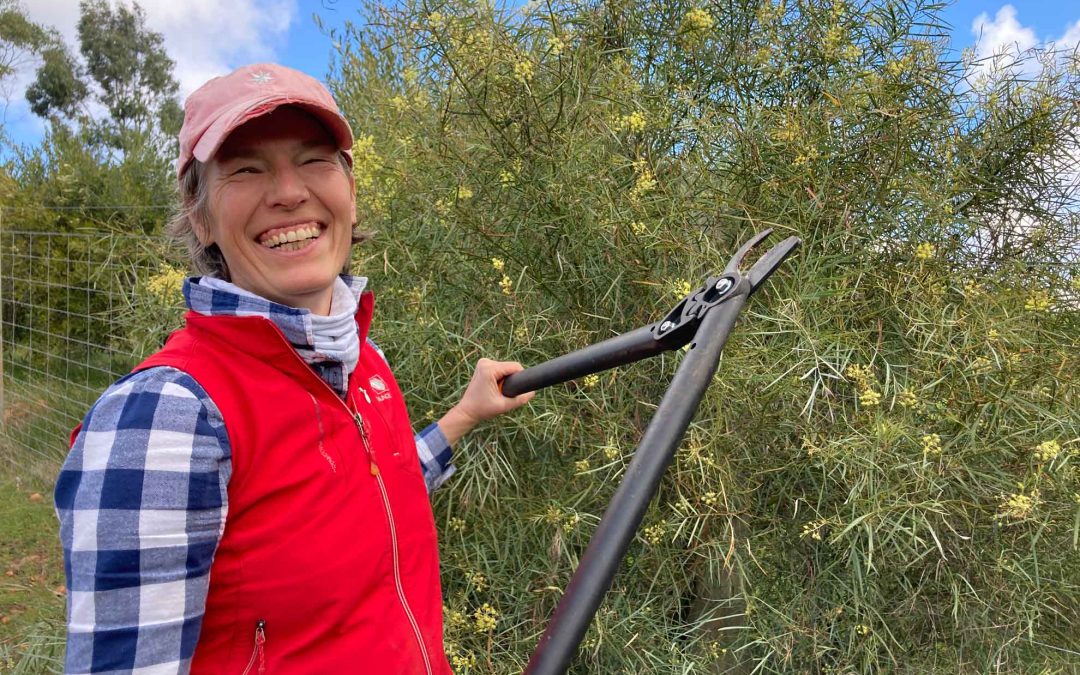Have you got this woody weed growing at your place? It’s a Flinders Range Wattle, which originates from South Australia and is a showy garden shrub growing to 5m. It’s flowering now and can be identified by its blue-green leaves and sprays of bright yellow globular flowers.
Nature Conservation Margaret River Region says the species is one of our region’s worst weed trees and is one of the species being targeted in its Woody Weeds Campaign. Everyone from suburban gardeners to bush block owners is urged to get on board and help stop the spread of the invaders, which jump from gardens to surrounding bushland and reserves.
Weedy shrubs and trees pose big problems by outcompeting native plants and dominating whole swathes of bushland. “They’re one of our biggest threats to native bush because they can spread vigorously, they outcompete local trees, and the seed can last for decades in the soil,” says Nature Conservation’s biodiversity officer Peta Lierich.
The campaign is aimed at raising awareness about our region’s most problematic weedy trees, such as Sydney Golden Wattle, Flinders Range Wattle, Victorian Teatree, Sweet Pittosporum and olives.
“We want everyone in the community to be able to ID our worst woody weeds, which in some cases can be confused with natives that belong here,” said MNs Lierich. “Once you’ve identified the invaders, you can either hand-pull seedlings or remove larger shrubs and trees with a pruning saw or chainsaw. Bigger jobs may need once-off qualified contractors or the Nature Conservation on-ground team to bring an infestation under control, but it’s worth it when you think of the threat to the surrounding forest.”
Stay tuned in coming months for Nature Conservation’s free workshops on identifying and removing woody weeds, with information, tips, photos and video shared on social media.
Local resident Gita Sonnenberg and her husband Norman are already on board with the campaign. They’ve removed more than a dozen large, weedy olive trees from their property on Kevill Rd as well as a Flinders Range Wattle close to adjacent bushland. “We are close to bushland and the Margaret River, so the last thing we want to do is be responsible for the spread of woody weeds from our place,” said Gita.
Ms Lierich said weedy shrubs and trees are often overlooked because people usually think of grassy garden plants when they think of weeds. “In fact, weedy shrubs and trees are one of our biggest threats to native bush because they can spread vigorously, they outcompete local trees, and the seed of many species can last for decades in the soil,” she said.
“If you have woody weeds on your property that pose a risk of spreading into bushland, we really encourage you to remove them because one tree can spread over a large area in just a few years. Instead, replace them with local natives, which complement our bushland and will be beneficial for our wildlife.”
The campaign is funded by the WA Government’s State Natural Resource Management Program, and includes funding to be spent on a 50-50 cost sharing basis with landholders located close to high priority bushland, reserves or national parks.
“If your property has a woody weed problem and is close to large areas of bushland or a national park, get in touch because you could be eligible for funding to bring in contractors to remove the shrubs or trees,” says Ms Lierich. To enquire about grant funding, email peta.lierich@natureconservation.org.au.

